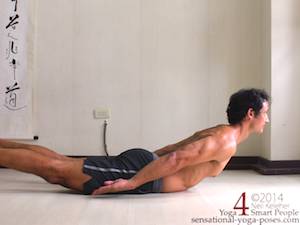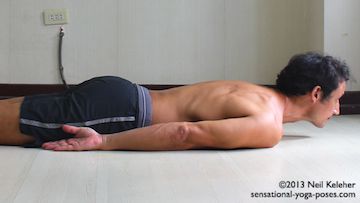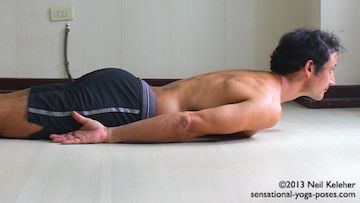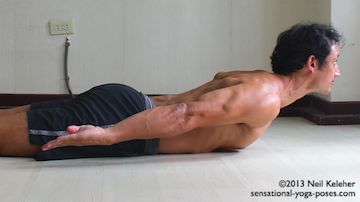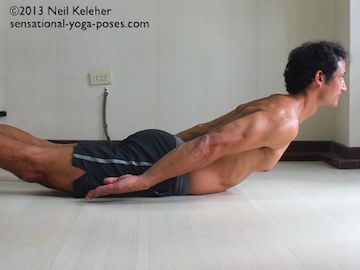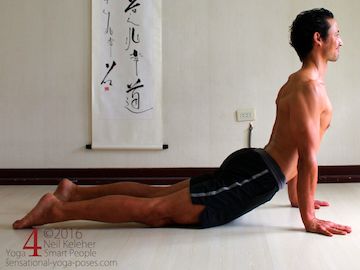A simple way to improve thoracic mobility
Because the ribcage is positioned to the front of the spine, and because the ribs can tend to get in the way of movements of the thoracic spine, one of the easier movements for mobilizing the thoracic spine is bending it backwards. This in turn causes the ribcage to "bend" backwards. It also changes the dimensions of the spaces between the ribs, which generally causes an increase in the volume within the ribcage meaning that the lungs will tend to expand. (The opposite movement can cause the volume of the lungs to decrease.)
To actively bend the thoracic spine backwards the main muscles of interest are the spinal erectors, transversospinalis and interspinalis muscles.
A Little Bit Of Anatomy
- The spinal erectors are the larger muscles which attach along the back of the spine. They tend to span multiple vertebral levels.
- The transversospinalis are smaller muscles which span the vertebral joints.
The rotatores span a single level,
the multifidus span two or three levels
while the semi-spinalis span five or six levels.
- The interspinalis muscles are the smallest of the lot spanning only single vertebral joints.
My experience and understanding is that the better you can feel your vertebrae and differentiate between them, then the more likely you are able to consciously activate the smaller muscles (as well as the larger ones.) This can mean finer controlled movement and also movements where all the elements of the spine are involved and working together to create smoothly curving backbends of the thoracic spine.
Also of interest are the intercostal muscles.
These are the muscles that are arranged between adjacent ribs and that can be used to "slide" the ribs relative to each other, directly varying the dimensions of the spaces between the ribs.
And so while it is easy to think of the ribs as impediments to ribcage and thoracic mobility, they are actually levers that we can use to either to stabilize the ribcage and thoracic spine or control it (moving it and changing its shape.)
Use Locust Pose to Feel Your Spinal Erectors
Locust pose is a great yoga pose for learning to activate the spinal erectors (and feel them active) because the muscles have to work against the weight of the head and ribcage in order to lift these elements off off the floor.
Lifting your head and bending your neck backward one vertebrae at a time
The first part of your body that you can lift off of the floor when doing Locust Pose is your head. If you keep your chest and shoulders down you can strengthen your cervical spinal erectors, the muscles that help to bend your neck backwards.
When these muscles activate you'll feel the tension in the back of your neck. To lift your head higher focus on increasing this tension. But do it gradually and smoothly so you don't damage yourself.
If you slowly lift your head off of the floor in this back strengthening yoga pose you'll feel your muscles first "taking up the slack" then you'll also notice the point at which your neck muscles exert enough pull to lift your chin off of the floor.
You can then focus on bending your neck backwards at each joint of your cervical spine.
Developing Cervical Spine Awareness
Although when I lift the ribcage and bend the spine backwards in locust pose I prefer to keep the neck straight (I focus on lengthening the back of my neck), with just the chin lifted you can use this opportunity to practice feeling the vertebrae of your cervical spine by bending your cervical spine backwards. There are seven in all spanning the distance between the base of the skull (at about the level of the ear holes) and the top of the ribcage (at about the level of the prominent vertebrae at the base of the neck.)
Starting with just enough tension in the neck so that the chin is lightly touching the floor you can try to gradually bend the cervical spine backwards by starting close to your head and working your way towards your ribcage.
There are seven cervical vertebrae and if you try counting each vertebrae as you move downwards, you have a way of roughly calibrating your awareness of your cervical vertebrae.
Generally I like to repeat this exercise a few times, resting the chin on the floor between sets. Then each time I repeat it I get better at tilting my cervical vertebrae backwards on at a time. If when I've reached what I think is the seventh vertebrae but my awareness is below that prominent spinous process of C7 then I know that my awareness increments were too big, and so I shorten them enough to get a better match.
Your Thoracic Spine has 12 Vertebrae.
Generally after repeating the above exercise a few times I then move onto bending the thoracic spine backwards one vertebrae at a time, starting from the top and working downwards. For this I first lift the head, but keep the back of the neck open. I pull my chin slightly towards my chest so that the back of my neck feels long. Then I'll try to gradually lift the ribcage by bending backwards one thoracic vertebrae at a time.
There are 12 thoracic vertebrae but to make it easier to "count vertebrae" I think of it in terms of an upper half and a lower half. The upper half has ribs that attach directly to the sternum and so consists of the upper 7 vertebrae while the lower half consists of the false ribs and the two pairs of floating ribs.
Having experienced the tension of the cervical spinal erectors when bending the neck backwards, the idea is to create that same feeling of tension in the back of the thoracic spine in order to bend the thoracic spine backwards. Because the ribs are also affected you could also focus on the ribs.
The feeling can be like you are peeling your ribs off of the floor one pair at a time.
To make this easier I tend to focus on feeling the back of my spine. Since bending the thoracic spine backwards will cause the front of the ribcage to open, you can help your spine bend backwards by reaching your ribs forwards at the same time.
Initially I may focus on just the upper half of the thoracic spine. I'll take a breath and focus on bending backwards and the first thoracic joint. Then I'll take another breath and focus on the next vertebral joint and so on. Then I'll take a rest, and then repeat, only this time including the lower half of the thoracic spine.
Note that I don't do locust pose this way all of the time. I may focus on just bending my spine backwards by activating my spinal erectors. Rather than "lifting" the ribcage, my focus is on bending it backwards so that it curls off of the floor.
Create Space at the Back of Your Body
One of the ways that you can create space in your upper body so that it is easier to bend your spine backwards is by lifting "the backs of your ribs."
"Lifting" the back ribs, or in the case of locust pose, moving them forwards, is caused by a set of muscles called the Levator Costarum. These muscles are situated in the same region as the spinal erectors and so if your spinal erectors are active, you may find it relatively easy to also activate your levator costalis.
Focus on feeling the back of your ribcage, and pulling the backs of your ribs towards your head.
You can pull the back of your head away from the back of your ribcage so that your neck is long also.
Continue to "create space" even as you bend your thoracic and cervical spine backwards.
Create Space at the Front
If you want to open the front of your ribcage more, try using the muscles at the front of your neck. Imagine pulling your sternum towards you chin.
You may find that squeezing the inner edges of your shoulder blades together helps you to open the front of your chest a little bit more.
If you don't want to "squeeze" your shoulder blades together, focus instead on making the front and back of your shoulders feel open.
Reaching Your Legs Back and Up
With your legs on the floor you can reach your knees away from your hip joints to create space in your hip joints. Keep your knees straight and pointing down. Reach back through your toes.
When lifting your legs you can focus on pulling up on the inside of the knee, above the knee joint. Let the weight of your outer thighs "hang down" a little so that you knees naturally point down. This then uses the adductor magnus longhead muscle to lift the thighs with minimal effort.
Another option is to use the buttocks and hamstrings to help lift the thighs. In either case work at keeping your knees straight and pointing downwards. And make your legs feel long.
Airplanes, Superman and a Clap
To make locust pose harder, the arms can reach out to the sides or forwards. With arms out to the sides the palms can face down. With arms forwards you may find it more comfortable to turn the hands so that the palms face inwards. (You can add a clap if you wish!)
With the arms reaching forwards focus on reaching the arms forwards. Actually this idea can be applied to the whole body. Try to reach the spine forwards as you curve it backwards. To help, reach the ribs and head forwards, away from the pelvis. At the same time reach the legs backwards, as if trying to pull backwards away from your pelvis.
You May Be Interested In...
Should your spinal erectors be active in Cobra pose or Upwards Facing Dog?
Locust Pose is one of several yoga poses and exercises for strengthening the back of the body.
Find out more about strengthening the glutes and hamstrings.
Did you know that locust pose is one type of Active Stretch. Learn more about active stretching in the Muscle Control for Better Flexibility.
Published: 2011 07 16
Updated: 2023 03 31
